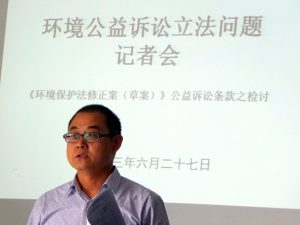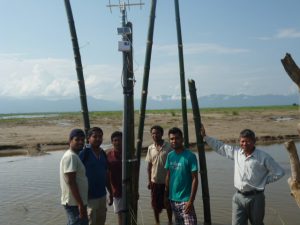After two years China’s first public interest lawsuit brought by NGOs still has no result.
Since 2011 Friends of Nature and the Chongqing Green Volunteer Association have been investigating the dumping of 5,000 tonnes of cadmium waste in Luliang county, culminating in a suit against Heping Technology and Luliang Chemicals. Because the NGOs were unable to cover the high costs of appraising the harm done, the two parties opted for pre-trial mediation. The defendants subsequently rejected a deal including remedial works and risk evaluation, meaning the case proceeded to a new hearing.
The complications of the case have led legal experts to reconsider China’s public interest lawsuits. Wang Canfa, a professor at the China University of Politics and Law (CUPL) says there is a long list of problems, such as that major local taxpayers and local courts have shared interests, civil society is weak, legislation on public interest lawsuits is lacking or too narrow and there are only a small number of bodies able to bring lawsuits. Another issue is that the appraisals needed in evidence are expensive and difficult.
American environmental lawyer Philip Boxell compared China and the US to explain why he believes the root of China’s problems lie in the legal system.
“US law is very detailed, very specific and complex. All promulgated laws have been through judicial interpretation.”
He went on to say that because US federal and state courts can issue interpretations of laws about to come into effect, this increases the chance that laws are practical. The fact that more than 50% of legislators in the US are lawyers also means bills are more likely to be supplemented and improved during discussions.
Although Chinese laws are subject to repeated examination by the National People’s Congress Standing Committee, those laws have many brief articles, allowing for more flexible judicial interpretation. And with no equivalent of US state law, the legislative system is much less refined.
Hu Jing, a deputy professor at CUPL, also advocates learning from the US. He said that if, as in the US, lawsuits were brought by the environmental authorities, the collection of evidence and appraisals would be much easier and more forceful. Meanwhile, America’s Comprehensive Environmental Response, Compensation, and Liability Act (also known as the Superfund Act) provides for a special fund to pay for restoration of polluted sites. These two practices would remedy the current failings of China’s system.
Li Bo, former director of Friends of Nature, offers another example. The industrial state of New Jersey is heavily polluted, especially with hexavalent chromium. One of the three sources of that pollution, PPG Industries, ceased production in 1974, but is still cleaning up pollution today.
Can the American model work in China?
When it comes to environmental public interest lawsuits, there are big differences between China and the US in terms of how common they are, how systematically they are used, and how specialised the procedures are.
The US has no specific rules on public interest lawsuits and under most circumstances anyone can bring what is called a ‘citizen suit’. Organisations or individuals can also sue the government for failing to enforce environmental laws. Nor does the US have environmental courts – environmental cases are heard in ordinary courts.
The US Environmental Protection Agency (EPA) sues polluters, oversees clean-up, and employs a staff of scientists and lawyers. The EPA has several hundred lawyers able to appraise incidents of pollution and investigate methods of restoration.
In the US public interest lawyers, who started working on environmental litigation on a no-fee basis in the 1970s and 1980s, also account for a large proportion of environmental lawsuits.
But in China Wang Canfa’s Centre for Legal Assistance to Pollution Victims is one of only a few bodies providing free legal services. China has responded by setting up courts specifically to hear environmental cases, and passing legislation on environmental public interest lawsuits. But it seems difficult for the Ministry of Environmental Protection to bring cases.
Xia Jun of Beijing Zhongzi Law Office said that environmental authorities are not keen to bring such cases as “becoming the plaintiff indicates they have failed in their duties, and they might be held accountable for that.” A good example is the MEP’s recent statement that data on soil pollution is a state secret.
Xia thinks the right to bring cases should lie with the Procurator. This avoids the conflicts of role faced by government bodies and environmental authorities and would also provide the necessary staff, funding and appraisals.
Another key difference at present is that in China the new environmental public interest lawsuits tend to be about compensation for harm done, rather than removal of pollution and restoration of the environment.
Zeng Xiangbin, an environmental lawyer, said that environmental courts were founded to assign responsibility for pollution and restoration. But if the costs of soil and water remediation are beyond the means of the defendant, judgements are meaningless. “It could take 20 or 30 years, but you have to finish restoration.”
Thanks to Jay Monteverde of the American Bar Association’s Rule of Law Project for assistance with this article.







